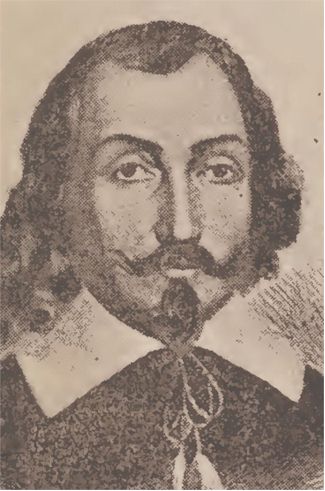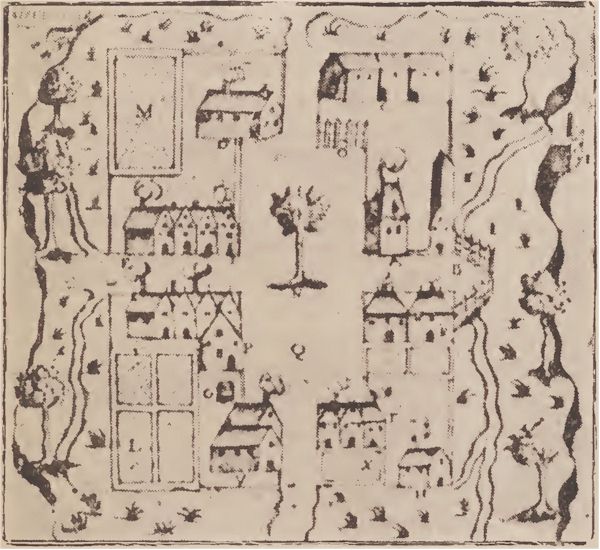Along the Maine Coast with Champlain
It was right away after Poutrincourt's
return to France that Champlain started ont on an enterprise of
his own. He had long cherished an ambition to search ont the
fabled city of Norumbega, which, he reckoned, could not be many
leagues from St. Croix, and find out for himself how much truth
there was in the glowing reports of David Ingram.
I may as well tell you now that in this
Champlain was disappointed. He confessed that there are none of
the marvels which some persons have described, "although he
visited the precise location of Pentagoet. He recorded with some
disgust, "I will say that since our entry where we were, which
is about twenty-four leagues, we saw not a single town nor
village nor the appearance of one having been there, but only
one or two huts of the savages where there was nobody. "
 |
| Samuel Champlain |
Marc Lescarbot, also, wrote in his usual
blithe style: "If this beautiful town ever existed in Nature, I
would like to know who pulled it down, for there is nothing but
huts here made of pickets and covered with the bark of trees or
with skins."
It was the second or third day of
September that Champlain set out with, some historians say,
twelve, and some say seventeen men of the colony and two Indians
as guides, in his "patache." This big, open boat, fitted with a
lateen sail and oars, is pictured in Champlain's drawing of the
St. Croix settlement.
The second day out they passed an island
some four or five leagues long. "The island is high and notched
in places so that from the sea it gives the appearance of a
range of seven or eight mountains. The summits are all bare and
rocky. The slopes are covered with pines, firs and birches. I
named it Les Isles des Monts Deserts," Champlain wrote. And this
is the first account of the naming of Mount Desert Island, on
which is Bar Harbor, the now famous summer resort.
"On the third day the savages came alongside and talked with our
savages. I ordered biscuit, tobacco and other trifles to be
given to them. We made an alliance with them and they agreed to
guide us to their river of Peimtgouet, so called of them, where
they told us was their captain, named Bessabez, chief of that
place."
The river was the Penobscot we know so
well, and the stopping place, where the council with the Indians
was held, was the present site of Bangor.
Champlain, continuing on his voyage of
discovery, sailed down the river, passed out by Owl's Head and
westward to the Kennebec, which he called Qinnibequy. He arrived
at St. Croix, having been away just a month. They did not reach
the settlement any too soon. Snow fell that year as early as the
6th of October, and by Christmas, as you have already seen,
winter had set in with unusual severity.
 |
| Champlain's Sketch of St. Croix
Settlement |
''Hoary snow-father being come," as the
poetical Lescarbot expresses it, ''they were forced to keep much
within the doors of their dwellings."
When the north winds swept down the
river and whistled through the rows of cedars, the sole
protection of the island against the wintry blasts, the poor
Frenchmen did not venture out-doors, but shivered around their
fires and Champlain remarked that "the air that came in through
the cracks was colder than that outside.'' There were no cellars
under the houses so vegetables and every liquid froze. Champlain
mentions dealing out the frozen cider by the pound.
Their fare, too, was scanty. They ground their grain, as they
needed it, in a hand mill, a tiresome process. They had salt
meat only. This soon began to affect the health of the men.
Scurvy broke out. The colony physicians had all they could do,
but it is not likely that they had the proper medicines, and out
of the seventy-nine men, thirty-five died before spring and
others were bloated and disfigured.
It was not until the fifteenth of June,
as the guard went his rounds a little before midnight that
Pont-Grave, so long and anxiously awaited, came in a shallop,
with the news that his ship was but six leagues away, lying
safely at anchor. There was great rejoicing at the settlement
and little sleep for anyone for the rest of the night.
Two days after the arrival of
Pont-Grave's ship, Champlain set out on a second voyage down the
coast. With him were M. Simon and several other gentlemen and
twenty sailors to man the boat, also the Indian, Panounais and
his squaw, as guides.
It was an eventful voyage and Champlain
writes fully and entertainingly about it.
Near Prout's Neck more than eighty of the savages ran down to
the shore to meet the strangers, "dancing and yelping to show
their joy.''
The Indians believed there was some
magic about Champlain and his companions, who, they said, "must
have dropped from the clouds." When Champlain was invited to a
feast of the Indians, he was told by his Indian guide that he
must not refuse. So he took his place among them, "squatted on
the skins spread for the guests of honor, around large kettles
of fish, bear's meat, pease and wild plums, mixed with the
raisins and biscuits they had procured in trade with the white
men, the whole well boiled together and well stirred with a
canoe paddle."
When Champlain showed great hesitancy in
eating the portion set before him, we are informed in the
chronicles that his hosts tried to tempt his appetite with a
large lump of bear's fat, a supreme luxury in their estimation,
whereupon he took a hasty leave, stopping only to exclaim, "Ho,
ho, ho," which his guide informed him was the proper way of
saying "please excuse me," to an Indian host.
On July twelfth, Champlain and his party
left the Front's Neck vicinity and steered their course ''like
some adventurous party of pleasure," we are told, by the beaches
of York and Wells, Portsmouth Harbor, Isles of Shoals, Rye Beach
and Hampton Beach, and into Massachusetts Bay, which they
explored at their leisure. Champlain was the most troubled by
the mosquitoes, which ''pestered him beyond endurance," to use
his own words.
DeMonts found no place on the
Massachusetts coast more suitable for his colony than St. Croix
and by July 29 they were back at the mouth of the Kennebec,
where they had an interview with the Indian chieftain, who gave
them news of another European ship on the coast. From their
description it must have been the Archangel, commanded by George
Weymouth, who was navigating the New England coast at that time.
It is the only reference made to Weymouth in any of Champlain's
writings.
Provisions were getting low, so they
steered once more for St. Croix. Aside from the killing of the
sailor by the Indians, but one other tragedy marked the year of
1605. It was the killing, by the Penobscot Indians, of their
faithful guide, Panounais. The body of the dead Indian was
brought from Norumbega to his friends in St. Croix, where an
imposing funeral was held. You may like to read Champlain's
description of the savage ceremony. He writes:
"As soon as the body was brought on
shore, his relatives and friends began to shout by his side,
having painted their faces black, which is their mode of
mourning. After lamenting much, they took a quantity of tobacco
and two or three other things belonging to the deceased and
burned them some thousand paces from our settlement. Their cries
continued until they returned to their cabin. The next day they
took the body of the deceased and wrapped it in a red covering,
which Mambretou, chief of the place, urgently implored me to
give, since it was handsome and large. He gave it to the
relatives of the deceased, who thanked me very much for it.
"And thus, wrapping up the body, they
decorated it with several kinds of malachiats; that is, strings
of beads and bracelets of divers colors. They painted the face
and put on the head many feathers and other things, the finest
they had, then they placed the body on its knees, between two
sticks, with another under the arms to sustain it. Around the
body were the mother, wife and other of the relatives of the
deceased, both women and girls, howling like wolves.
"While the women and girls were
shrieking, the savage named Mambretou made a speech to his
companions on the death of the deceased, urging all to take
vengeance for the wickedness and treachery committed by the
subjects of the Bessabez, and to make war on them as speedily as
possible. After this the body was carried to another cabin and
after smoking tobacco together, they wrapped it in an elk skin
likewise and binding it very securely, they kept it for a larger
gathering of savages, so a larger number of presents would be
given to the widow and children."
Soon after this, DeMonts and Champlain
moved the whole settlement to Port Royal. DeMonts soon sailed
for France. The indomitable Champlain volunteered to brave
another winter in the wilds and we are glad to read in his
journal that "We spent the winter very pleasantly."
And now that you have followed
Champlain's adventures along the Maine coast, you may want to
trace them further, among the Indians of Vermont, New York and
the Great Lakes region, and to learn how he became the father of
Canada; how his blithe courage planted the fleur-de-lis on the
rock of Quebec. There, on Christmas day of 1635, just thirty-one
years after his Christmas celebration in Maine, he died,
striving to the last for the welfare of his colony, "for the
glory of France and the church."
As for St. Croix, which he first helped
to settle, it was never after deserted for long at a time. It
remained the most southern foothold of the French until the
cession of Canada to the English in 1763.
Emmie Bailey Whitney.
|
![]()
![]()